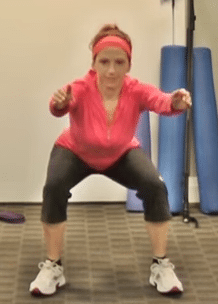Squatting is a great exercise for a variety of reasons. It helps improve your overall strength and flexibility, as well as build muscle mass and improve your posture. However, many people find that squatting causes knee pain. This can be due to how the knees are placed, how deep they’re squatted, or how you approach the exercise. In order to avoid knee pain when squatting, here are three simple tips before you get started.
How to Squat Without Knee Pain
CLICK HERE to watch the YouTube video.
1. Feet a little wider apart and toes out

If you find your knees in pain during the squat exercise, try widening your feet. This will decrease the pressure on the front of your knees. If you’re not sure how to do this, it can be a good idea to use a box or some other type of step to help place your feet wider apart so they can be more comfortable during the exercise.
This will give your pelvis somewhere to go so you can squat properly. Position your toes slightly outwards. Another thing to remember is that your knees should be strong over the foot. Don’t let your knees collapse.
2. Start the squat movement with your hip
Many people take the squat movement too quickly, which can cause their knees to buckle. The next time you’re squatting, try starting the movement using your hips instead of your knees. This will ensure that your knees don’t buckle and keep you safe while working out. It is like you are reaching back with your seat to sit in the chair. Squatting involves some knee movement and a lot of hip movement. You need to distribute your weight throughout your foot, not on your toes. If you put too much weight on your toes, it will put a lot of strain on your knees, leading to more knee pain. You have to put the weight in the midfoot or heel.
3. Hips pass the knees
When squatting, especially when lifting heavy weights or going deep, your knees should be behind your hips. If you’re not sure how deep to go (or if you want to go deeper), place a bench or chair in front of you so that your hips are lower than the level of the chair. This will give you an idea of how deep to go before feeling any pain.
You should have your hips past your knees when you squat. Usually, the toughest position is getting out of the bottom position. So if the hips are above the knees, this is probably a knee movement. If you let the hips move just past the knee, you can get more help from the hamstrings and the glutes to get out of the bottom position.
Outlook
If you find that squatting causes pain in your knees, there are a few things to consider. It’s always best to consult with your doctor before adding any new workout or exercise back into the mix. If all else fails, check out some other exercises such as lunges, which can help prevent knee injury.
If you want to get rid of your nagging knee discomfort permanently, then click here to check out the Knee Pain Solved program.